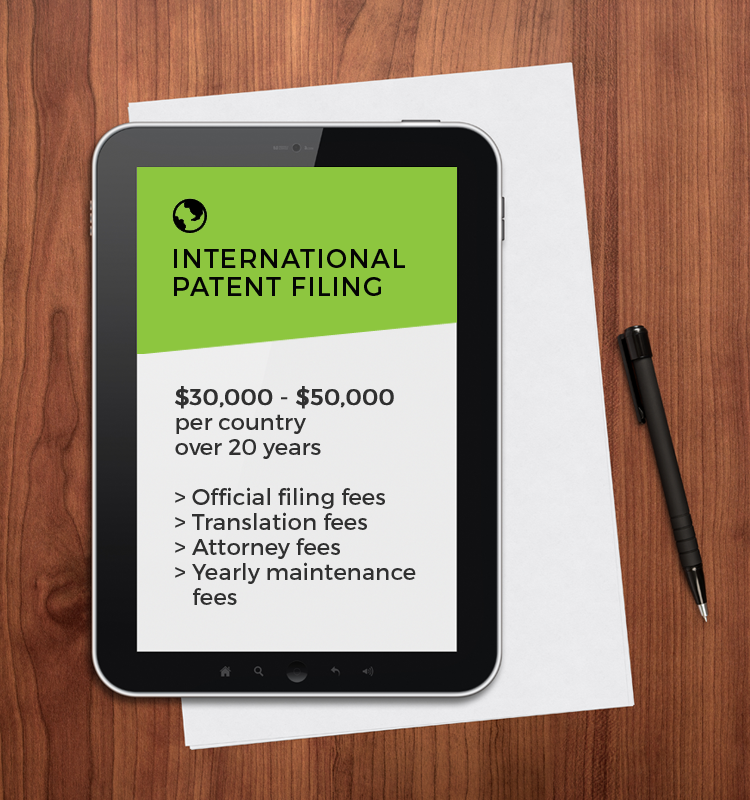27 Mar 2024
Early-stage tech companies often focus on establishing themselves in the domestic market first, meaning that they only consider breaking into international markets after achieving local success.
But if you don’t plan early, you may not be able to protect your invention in foreign countries — which can be a costly mistake.
Patent rights are territorial, meaning that a patent granted in the United States has no effect in a foreign country. And when seeking patent protection outside the United States, you face a limited timeline and strict procedures.
If your business has potential competitors, customers or collaborators abroad, keep the following key procedures and considerations in mind — they’ll ensure your patent portfolio maintains an international focus that’s aligned with your business strategy.

Options For Filing a Patent Application Internationally
For U.S.-based companies, there are two general paths to extend patent protection outside the United States: the Paris Convention and Patent Cooperation Treaty (PCT). The path that’s more appropriate for your needs will depend on how many countries you plan to file in, and how quickly you want foreign protection.
Paris Convention
The Paris Convention has been around for over a century and currently has 177 member countries. It allows you to use your U.S. application filing date as the effective filing date in one or more foreign countries— provided you file in those countries within a year of your U.S. filing.
Your U.S. application and each foreign application will be evaluated independently, according to each country’s respective laws and examination procedures. The application filed in each country can mature into a patent when approved by that country’s patent office.
Patent Cooperation Treaty (PCT)
Developed around 1970, the PCT allows you to file a single “PCT” (aka “international”) application that is effective as an initial patent application in all PCT member states (as of this post’s publish date, there are 157 member states).
Filing the PCT application beings the “international stage” of the patent process. During the “international stage,” the PCT application receives preliminary processing and substantive examination. But the PCT application itself never matures into a patent.
Within 30 months of the PCT application’s earliest claimed priority date, you must “nationalize” your application in the individual jurisdictions (such as the European Patent Office or China) where you want to receive a patent. During this “national stage,” the individual jurisdictions each examine your application independently. The national stage application filed in each country can then mature into a patent when approved by that country’s patent office.
Choosing Between the Two
With the Paris Convention, you must foreign file in each individual country within a year of your initial U.S. filing. Therefore, you incur the initial cost of each foreign filing over a period of about 12 months.
As such, we typically recommend Paris Convention filings under two circumstances:
- When you know you want to seek protection in only one to two countries outside the United States, and
- When speed is critical
Otherwise, we generally recommend filing via the PCT. It defers costs by giving you an additional 18 months of breathing room before you have to begin the national stage, which is often the most expensive part of the process. The PCT also provides an initial round of examination, so that you can evaluate the likelihood of success before you incur the cost of national stage filings.
Questions To Ask About Your International Patent Strategy
To determine where you want to file for patent protection, ask yourself the following 4 questions:
1. Do You or Your Competitors Have Business Outside the United States?
In today’s global economy, virtually every tech company could potentially have engagements outside the United States. For example, your foreign engagements might include sales to foreign customers, manufacturing in foreign countries, or licensing to foreign entities.
And even if your business has a purely domestic focus, your competitors might be able to gain an edge over you by manufacturing overseas or selling through foreign markets.
For these reasons, every tech company should at least consider foreign patent protection as part of their overall intellectual property strategy.
That being said, if your technology isn’t relevant to a particular foreign market or region, then it wouldn’t make sense to file a patent application in that country. For example, patent protection for oil and gas drilling technology would not typically be valuable in regions of the world without access to oil and gas reservoirs.
2. Why Are You Seeking Patent Protection?
The focus of your overarching patent strategy will affect where you decide to seek patent protection. Common goals of a patent strategy include:
- Exclusive market share for your technology
- Preventing competitors from copying or stealing your technology
- Licensing your invention to wider markets
- Seeking funding from venture capitalists or acquisition by larger companies
With these factors in mind, you should consider filing in countries where your business, your competitors, or your potential licensees have operations or customers. Also, look at the companies owned by the venture capitalists or larger companies that might invest in your business, and consider filing in countries where those companies have sought patent protection.
3. What’s Your Budget?

Seeking patent protection outside the United States can be much more expensive than a U.S. application. Moreover, you’ll need to file a separate application for every country you’re seeking protection in!
We recommend budgeting $15,000–$50,000 per country over the 20-year life of the patent. The costs include:
- Official filing fees charged by each country’s patent office
- Translation fees for foreign countries that require a non-English translation
- Legal fees to hire an attorney who’s licensed to practice in each jurisdiction
Maintenance fees (also known as “annuities” and “renewal fees”), which are often assessed annually by foreign patent offices
4. What’s Your Timeline?
How urgently does your business need foreign patent protection? If you’re competing in a fast-changing industry, and your product may lose its competitive edge within a few years, you may prefer to file under the Paris Convention to obtain a patent grant and monetize your technology as soon as possible.
Also, take steps to ensure that your date of first public disclosure doesn’t precede your initial patent filing dates. While U.S. filings enjoy a one-year “grace period” from the date of your first public disclosure or sale, most other countries don’t. So start planning to file your patent application well in advance of sharing any details about your invention or selling your product.
Finally, keep in mind that under U.S. law, for inventions made in the United States, you must have a foreign filing license before you can file a patent application outside the United States. The U.S. patent office automatically evaluates each new U.S. patent application as a request for a foreign filing license. Though these automatic requests are often granted quickly, in some cases, it can take several months. So if you need to file foreign applications immediately, you can petition for an expedited foreign filing license and the U.S. patent office will usually respond within a few days.
When filing a patent application, it’s critical that you keep track of all dates and deadlines to ensure that your applications are filed in a timely manner. If you miss a deadline, your application might end up being worthless.
Do Startups Really Need International Protection?
Startups should always strongly consider filing PCT applications, as they keep virtually all options on the table for two and a half years — without significant cost. And it’s especially important if you’re thinking about fundraising from outside investors, because many investors will want to see that you’ve taken reasonable steps to protect your technology in major markets.
If you have the budget to file in multiple countries, the rule of thumb is to file in the countries where you or your competitors will exploit (manufacture, distribute, sell or use) the technology.
Don’t have the budget? It’s very common to file in the United States only. One unique advantage of this strategy is that you can choose to keep the application secret unless and until you get an issued patent. By contrast, if you file a PCT or foreign application, the U.S. patent office will automatically publish your application 18 months after it’s filed.
Keep in mind that even very large companies with huge budgets typically select between three to five countries for their important patent applications. They often keep less important applications in only the United States, or the United States and European Patent Office. And it’s incredibly rare for a patent application to be filed in more than 10 to 15 countries.
Ready To File a Patent Application?
If you’re considering building a strong international patent portfolio, you first need to make sure you have all the right resources at your disposal.
Henry Patent Law’s free checklist can help you figure out if you’re really ready to commit to the process — download it now!
IS IT TIME TO START BUILDING YOUR PATENT PORTFOLIO? WE’LL HELP YOU FIND OUT!
When you’ve got game-changing technology on your hands, you can’t wait to share with the world — which also means protecting it from competitors.
But is now the right time to start moving forward with the patent process? Download our FREE checklist to find out. Learn the following:
- What does a patent really do?
- Does your invention have substance?
- Do you have all the necessary resources lined up?
- Is your business structure — and all the logistics — ironed out?
- How should you proceed if you’re not quite ready to begin the patent process?
Dive deep into the patent process and get all your IP readiness questions answered.
Fill out the short form on this page to download this checklist today!
GET THE FREE CHECKLIST

Michael K. Henry, Ph.D.
Michael K. Henry, Ph.D., is a principal and the firm’s founding member. He specializes in creating comprehensive, growth-oriented IP strategies for early-stage tech companies.

